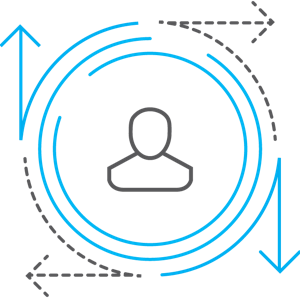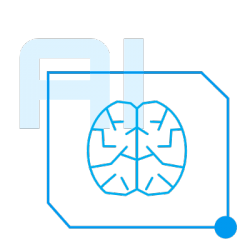ARTIFICIAL
INTELLIGENCE
EVOLVE YOUR COMMUNICATION
Until recently “artificial intelligence” (AI) was still considered “science fiction.” With the integration of “artificial intelligence” (AI) in the everyday work of small and medium-sized enterprises, however, it is no longer considered unusual.
For example, intelligent machine interaction in telephony is already being used on many hot lines in interactive voice response (IVR) to evaluate customer requests so that these calls can be “pre-sorted” for subsequent human editing.
The advanced, completely machine-based self-service structure is already used in customer communications.
The largest role still played by AI in this area is the ability to ensure quick customer service.
With the integration of AI, quality assurance may also be supported.
The use of AI in customer communications enables the immediate handling of all ad-hoc queries and the efficient distribution to live agents while simultaneously maintaining effective quality standards.
The purpose
Resumed in a few words, the main purpose for the use of AI in the Service Center branch is to be able to provide “an excellent customer service experience”.
When looked at in detail though, the use of AI with all its options can mean the taking over of the entire 1st level.
In consequence the live agent – in charge of 2nd level and beyond – becomes more important, as he’ll be enable to provide a far more efficient assistance to the customer, considerably contributing to increasing the allover customer satisfaction and therefore service quality.
You can’t really see how this should be possible?
Then keep on reading!
The approach
QUALITY ASSUREMENT
OPTIMIZATION OF THE ALLOVER PROCESS
SELF-LEARNING-PROCEDURE

The human interface
Imagine your AI as a new member of the team. A person that does not have any specific professional experience in this area, but is a very fast learner, capable of real multi-tasking and definitely willing to continuously keep learning and apply the new, assimilated content to its work practice.
In the beginning, this new co-worker will have to be trained. Someone needs to provide him with the knowledge and input necessary for him to successfully manage the tasks he’s been assigned with, and he’ll have to assimilate the implemented workflows as well as the do’s and don’ts.
The human interface – the coach of your AI – will be responsible for this and will be feeding the system. Subsequently it’ll be in charge of continuously correcting and adjusting until the stage of not more than a little fine-tuning is reached. If necessary at all.

You prefer reading offline?
Here you can download PDF’s on everything
that’s worth knowing.



